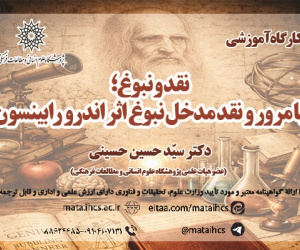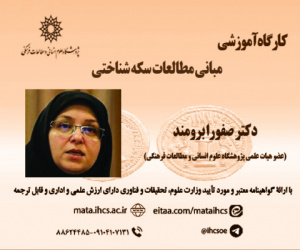تحدید، گام اول تشخص مکان
آرشیو
چکیده
کنده شدن از وجود بسیط، نخستین مرحله در ظهور تشخص و تبیین ماهیت است. وجود، همه هست و چیز نیست؛ ماهیت و چیستی ندارد. فقط هست. آن گاه که پاره ای از آن جدا می شود است که نام و اسم پیدا می کند. چیزهای عالم، پاره های هستی اند که با تحدید قابلیت های خود، چیزی شده اند و ماهیتی جداگانه یافته اند. در مسیر ماهیت یابی، نخستین اقدام، خط کشی میان شیء جدید با بقیه وجود است. مراتبی از وجود را دارد اما در جاهایی که خود را جدا کرده، محدودیت دارد. بخش جداشده از هستی، اگرچه در وجود با منشأ خود مشترک است، اما به واسطه برخی صفات و ویژگی های خاص «شیء و چیزی» می شود که با نام همان «واسطه» خوانده می شود. در فرایند تشکیل ماهیت، گام اول تعیین مرز و حدود است. مرز، استقلال موجود را تأمین می کند. همان مرز، مرتبه شیء را تعریف می کند و با صفاتی که ناشی از مرتبه اوست، ماهیت شیء تبیین می شود. در ساحت وجود، اراده آفرینش چیستی جدید، مقدم بر لوازم آن از جمله لبه و مرز است؛ اما در عالم ماده، تعیین حدود، شرط پیدایش ماهیت جدید است. لبه و مرز در ساحت ماده نیز شرط شخصیت یابی و جداشدگی است. لبه، پایان دامنه یک چیستی را اعلام می کند و آغاز چیستی دیگر را بیان می کند.دزفول در آغاز در حاشیه رود دز تشکیل شد. دژپُل، قلعه ای که برای نگهبانی از پل برپا شده بود، نخستین محله شهر بعدی دزفول بود که چسبیده به ساحل دز، شهر را تدریجاً در عرصه بیکران دشت پدید می آورد. رود اگرچه لبه و مرز شهر بود، اما ساختار شهر را شکل می داد و سازمان فضایی شهر را متأثر از خود می کرد. مرز رود آن قدر قوی بود که تا چند دهه قبل، شهر را در یک طرف خود داشت. گویی در طول هزار و چند صد سال عمر دزفول، هیچ اندیشه ای جرأت عبور از لبه و فکر کردن به طرف دیگر را نداشت. شکل گیری و توسعه شهر، نه در فرار از لبه رود به معنای محدودیت جهت توسعه، بلکه با کشش لبه به سمت خود و استقرار حداکثری در حاشیه آن بود. لبه آنقدر قوی بود که در باور اهالی نیز آن سوی رود جایی پست و کم بها در قیاس با این سو شناخته شد. حتی طرح جامع نیز که بی پروا از نقش رود در قلمروسازی دزفول به آن طرف به عنوان اراضی سهل الوصول و ارزانی نگاه کرد که با یک پل داخل بافت شهر می شود، نتوانست با همه تمهیدات خود دوقطبی این سو-آن سو را تعدیل کند. همچنان رود، مرز درون و بیرون و شهر و بیابان باقی ماند. قلمرو، به مثابه سرزمینی که انسان با ربط دادن عناصر آن به یکدیگر و به خود، محدوده ای ذهنی ترسیم می کند و تعلقات خود را در آن پدید می آورد، با تحدید پدید می آید. قلمروسازی روش استقرار انسان در فضاست. مفهوم سازی از بخشی گزیده از دنیای بی نهایت پیرامون است به اعتبار عناصر درون آن و از همه مهمتر تعیین یک مرز با آنچه در بیرون است. حصار در مالکیت، افزون بر نقش قانونی و حمایتی، مظهر فاصله میان من و غیر است. قلمروسازی می کند و به ساکنان درون تعریف و هویت خاص می بخشد. این کار به واسطه قلمروسازی و آن هم به واسطه تبیین مرز و لبه ممکن می شود. والّا تشخص های اجتماعی و تاریخی امکان ظهور پیدا نمی کنند و عالم در حد تشخص های اولیه جغرافیایی و طبیعی باقی می ماند. از این روست که در فرایند برنامه ریزی فضایی از جمله طرح های جامع و تفصیلی برای توسعه شهر، لازم است تا نقش بنیادین عناصر اصلی سازمان فضایی و منظر شهری که زمینه ساز و بستر فهم از شهر هستند و واقعیت مفهوم شهر را می سازند، با دقت شناخته و حفاظت شود تا حس شهر و ادراک کلی شهروندان از شهر خود، تداوم پیدا کند. احساس تداوم هویت و زندگی در شهری که از قدیم بوده است، در زمره گرانبها ترین دستاوردهای برنامه های توسعه است. چنین رویکردی به عناصر پایه سرزمینی می تواند امکان توسعه مکان محور که برپایه شناخت سرزمین به مثابه «مکان» استوار است را فراهم آورد. اگرچه در شرایطی که اولین انتظارات از برنامه توسعه شهری، عبور سریع تر در خیابان ها و دفع آب های سطحی و جلوه فروشی برای ایجاد شهر مدرن است، صحبت از رویکرد مکان محور در توسعه شهری قدری بعیدالوصول به نظر می رسد، ولی چه می توان کرد که تا با گفتن و نوشتن، شناخت اراده ای خلق نشود، محصولی هم نخواهد رویید.Delineation, the First Step in Place Orientation
Detaching from simple existence is the first step in identifying nature. Existence is everything and nothing; it has no nature or essence. It only comes to being as soon as one part of it gets separated and given a name. The things of the world are parts of existence that turn into something by confining their functions and developing a distinct nature. In identifying existence, the first step is to draw a line between the new object and the rest of existence. There is a degree of existence, but it encounters limitations in the places where it separates itself. The detached part of existence, though it has an inseparable origin from its existence, due to some special attributes and characteristics, becomes an "object," which is called by the same name as "intermediate." In the process of forming nature, the first step is to delineate the boundaries. The border warrants the existing independence. The same border defines the rank of an object, and the nature of the object is explained by the attributes associated with its rank. When it comes to existence, the will to create a new entity precedes its requirements, including edges and borders, but in the world of matter, defining limits provides a condition needed for the emergence of a new nature. The edge and border in the field of matter also prepare a condition for personalization and separation. The edge determines the end domain of one entity and the beginning of another entity.
Dezful was formed along the edge of the Dez River. Dejpol, a fort that was built to guard the bridge, was the first neighborhood formed after the formation of Dezful along the coast, which gradually developed in the vast expanse of the plain. Although the river was the edge and border of the city, it formed the structure of the city and impacted the organization of the city. The border of the river was so strong that until a few decades ago, it created the city on one side. It is as if over thousands and hundreds of years of life, there was not any dare to cross the edge and think of the other side. The impression of the edge was so strong that it made the locals believe that the other side of the river was inferior and less valuable compared to this side. Even in the master plan, which disregarded the role of the river in Dezful territorialization, the other side was considered to be easily accessible and cheap land that gets connected to the city with a bridge and could not adjust the bipolarity between this and that side with all its measures.
The river served as a boundary between inside and outside, city and desert. The territory is a land where a person draws a mental boundary by relating its elements to each other and himself and creates relationships that are delineated by limitation. Territorialization is the method of human settlement in space. Conceptualization is a selected part of the infinite surrounding world shaped by the elements it contains and, most importantly, determining a boundary with what falls outside. The fence in ownership, in addition to the legal and protective role, is a manifestation of the distance between me and others. It territorializes and gives a specific definition and identity to its inhabitants. This work is possible through territorialization and also through the explanation of borders and edges. However, social and historical characteristics are not possible to emerge, and the world remains limited to the primary geographical and natural characteristics. Therefore, in the process of spatial planning, including comprehensive and detailed plans for the development of the city, it is necessary to carefully understand the fundamental role of the main elements of the spatial organization and urban landscape, which are the basis for understanding the city and create the reality of the concept of the city. It should be protected so that it fosters the ongoing feeling of the city and the general perception of the citizens about their city. The sense of continuity of identity and life in a city that has been around for a long time is among the most valuable achievements of development programs. Such an approach to the basic elements of the territory can provide the possibility of a place-oriented development based on the recognition of the territory as a "place." The first expectations from the urban development program seem to facilitate faster movements in the streets, dispose of surface water, and focus on the aesthetic appeal of the modern city while talking about a place-oriented approach to urban development seems a bit far-fetched. However, without speaking and writing on this subject, knowledge cannot be created, and action cannot be taken.









